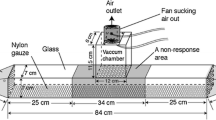Abstract
Synthetic (E)-9-oxo-2-decenoic acid (9-ODA) was as attractive to drones as ether extracts of queen heads, suggesting that 9-ODA is the component of the sex pheromone that attracts drones from a distance. However, other substances produced in the heads of both virgin and mated queens cause drones to hover near a lure. Positive anemotaxis and short-range visual stimuli are also involved in the mate-finding process. “Keeper” substances ensure the gradual release of the pheromone. (E)-9-Hydroxy-2-decenoic acid (9-HDA) did not attract drones from a distance or affect their behavior near a lure.
Synthetic 9-ODA was slightly attractive to worker bees from a queenless swarm and 9-HDA was not attractive. However, ether extracts of whole queens or queen heads contain unidentified substances that are highly attractive. These are produced more abundantly by mated laying queens than by virgin queens.
Similar content being viewed by others
References
Blum, M.S., Boch, R., Doolittle, R.E., Tribble, M.T., andTraynham, J.G. 1971. Honeybee sex attractant: Conformational analysis, structural specificity, and lack of masking activity of congeners.J. Insect Physiol. 17:349–364.
Butler, C.G. 1954. The method and importance of the recognition by a colony of honeybees (A. mellifera) of the presence of its queen.Proc. R. Entomol. Soc. 105:11–29.
Butler, C.G. 1967. Sex attractant acting as aphrodisiac in the honeybee (Apis mellifera).Proc. R. Entomol. Soc. (A) 42:71–76.
Butler, C.G. 1969. Some pheromones controlling honeybee behaviour.Proc. Cong. Int. Union for Study of Social Insects. 6:19–32.
Butler, C.G. 1971. The mating behaviour of the honeybee(Apis mellifera L.).J. Entomol. (A) 46:1–11.
Butler, C.G., andFairey, F.M. 1964. Pheromones of the honeybee: Biological studies of the mandibular gland secretion of the queen.J. Apic. Res. 3:65–76.
Butler, C.G., andSimpson, J. 1965. Pheromones of the honeybee (Apis mellifera L.). An olfactory pheromone from the Koschewnikow gland of the queen.Vedecke Prace (Dole) 4:33–36.
Butler, C.G., andSimpson, J. 1967. Pheromones of the queen honeybee (Apis mellifera L.) which enable her workers to follow her when swarming.Proc. R. Entomol. Soc. (A) 42:149–154.
Callow, R.K., Chapman, J.R., andPaton, P.N. 1964. Pheromones of the honeybee: Chemical studies of the mandibular gland secretion of the queen.J. Apic. Res. 3:77–89.
Eiter, K. 1962. Neue Synthesen der ‘Königinnensubstanz’ und der 9-Hydroxy-2-trans-decensäure,Justus Liebigs Annalen der Chemie 658:91–99.
Gary, N.E. 1961. Queen honeybee (Apis mellifera L.) attractiveness as related to mandibular gland secretion.Science 133:1479–1480.
Gary, N.E. 1962. Chemical mating attractants in the queen honeybee.Science 136:773–774.
Gary, N.E. 1963. Observations of mating behaviour in the honeybee.J. Apic. Res. 2:3–13.
Gary, N.E. 1970. Pheromones of the honeybee,Apis mellifera L. pp. 29–53,in D. L. Wood, R. M. Silverstein, and M. Nakajima (eds),Control of insect behavior by natural products. Academic Press, New York.
Gary, N.E., andMarston, J. 1971. Mating behaviour of drone honey bees with queen models (Apis mellifera L.)Anim. Behav. 19:299–304.
Goodrich, B.S. 1970. Cuticular lipids of adults and puparia of the Australian sheep blowflyLucilia cuprina (Wied.).J. Lipid Res. 11:1–6.
Hammann, E. 1957. Wer hat die Initiative bei den Ausflügen der Jungkonigin, die Königin oder die Arbeitsbienen?Insectes Soc. 4:91–106.
Morse, R.A. 1963. Swarm orientation in honeybees.Science 141:357–358.
Morse, R.A., andBoch, R. 1971. Phermone concert in swarming honeybees (Hymenoptera: Apidae).Ann. Entomol. Soc. Am. 64:1414–1417.
Morse, R.A., Gary, N.E., andJohansson, T.S.K. 1962. Mating of virgin queen honey bees (Apis mellifera L.) following mandibular gland extirpation.Nature 194:605.
Pain, J. 1961. Sur la pheromone des reines d'abeilles et ses effects physiologiques.Ann. Abeilles 4:73–152.
Pain, J., andRuttner, F. 1963. Les extraits des glandes mandibulaires des reines d'abeilles attirent les males, lors due vol nuptial.C.R. Acad. Sci., Paris, Ser. D 256:512–515.
Renner, M., andBaumann, M. 1964. Uber Komplexe von subepidermalen Drüsenzellen (Duftdrüsen) der Bienenkönigin.Naturwiss. 51:68–69.
Shearer, D.A., Boch, R., Morse, R.A., andLaigo, F.M. 1970. Occurrence of 9-oxodec-trans-2-enoic acid in queens ofApis dorsata, Apis cerana, andApis mellifera.J. Insect Physiol. 16:1437–1441.
Simpson, J. 1963. Queen perception by honey bee swarms.Nature 199:94–95.
Strang, G.E. 1970. A study of honey bee drone attraction in the mating response.J. Econ. Entomol. 63:641–645.
Velthuis, H.H.W. 1970. Queen substances from the abdomen of the honeybee queen.Z. Vergl. Physiol. 72:210–222.
Velthuis, H.H.W., andVan Es, J. 1964. Some functional aspects of the mandibular glands of the queen honeybee.J. Apic. Res. 3:11–16.
Author information
Authors and Affiliations
Additional information
Contribution Numbers 400 and 801 from Ottawa Research Station and Chemistry and Biology Institute, respectively.
Rights and permissions
About this article
Cite this article
Boch, R., Shearer, D.A. & Young, J.C. Honey bee pheromones: Field tests of natural and artificial queen substance. J Chem Ecol 1, 133–148 (1975). https://doi.org/10.1007/BF00987726
Issue Date:
DOI: https://doi.org/10.1007/BF00987726




